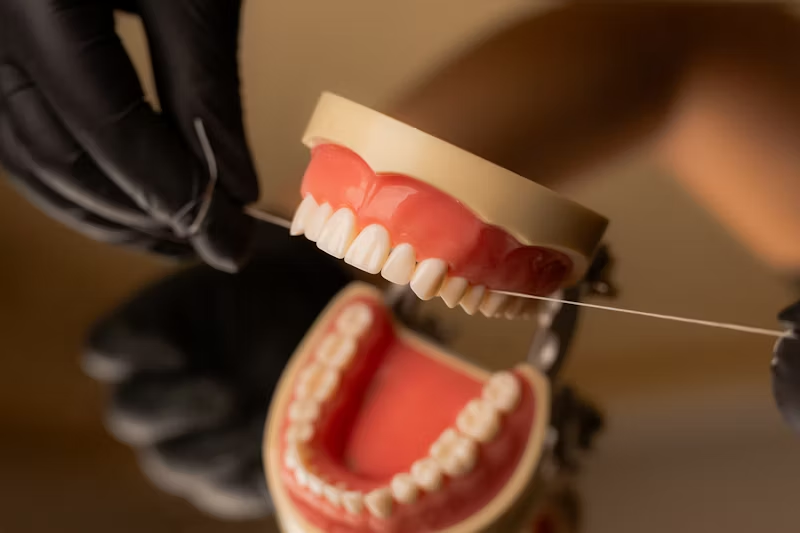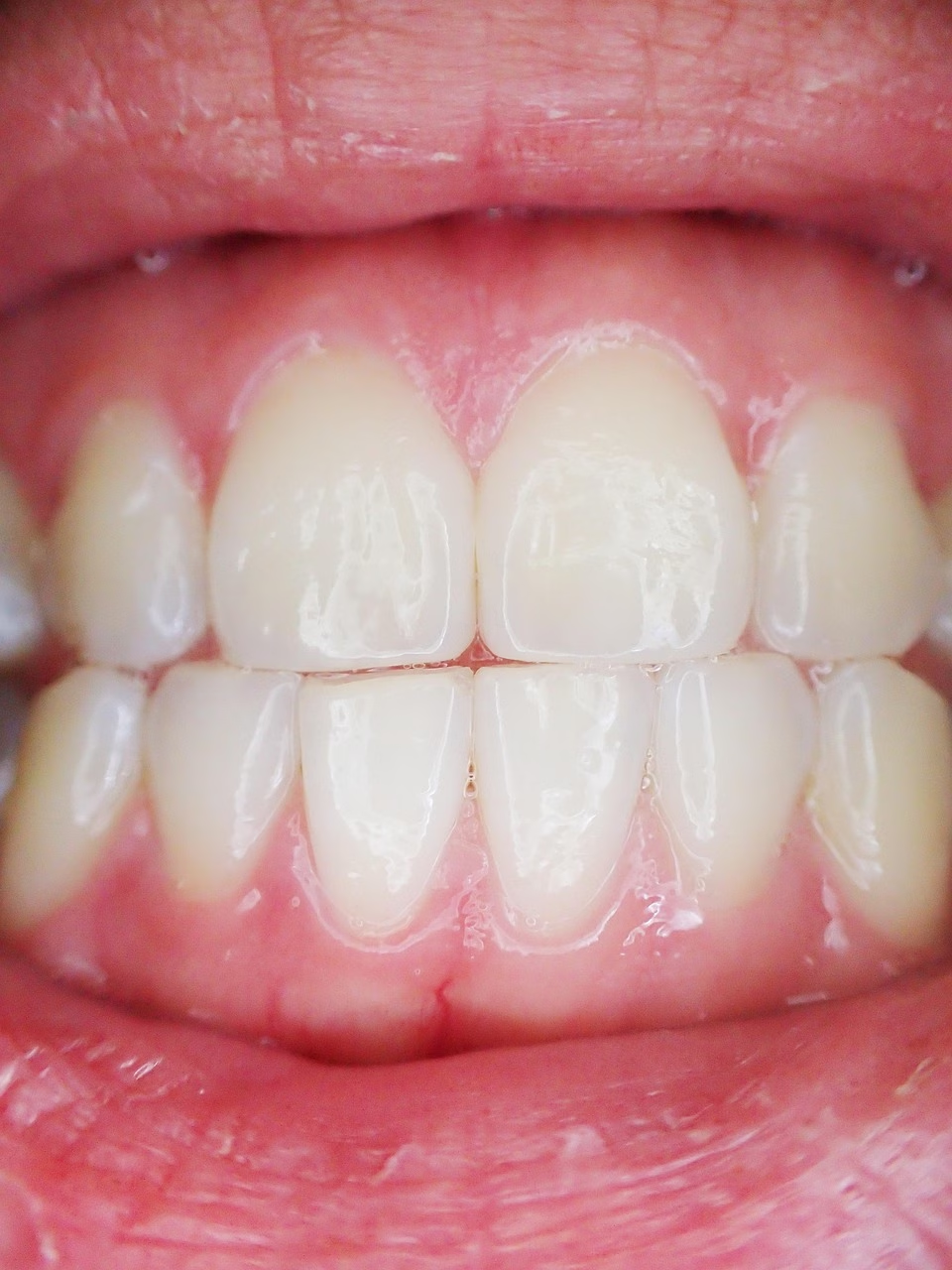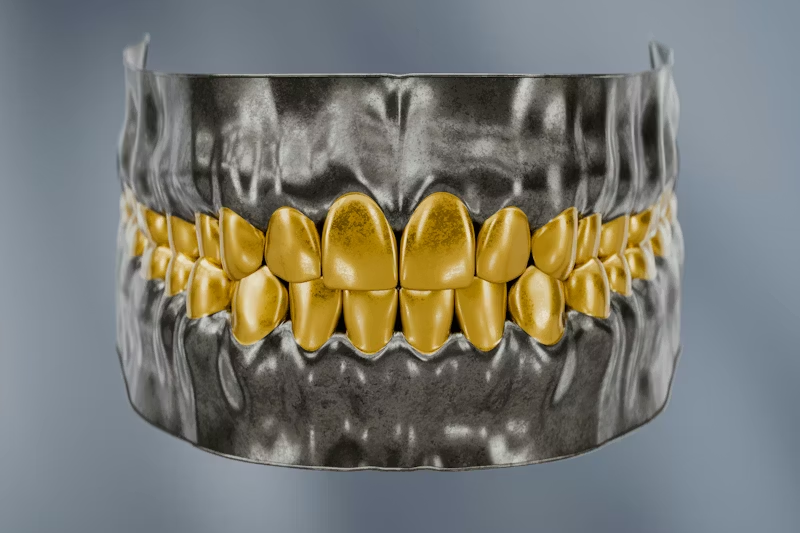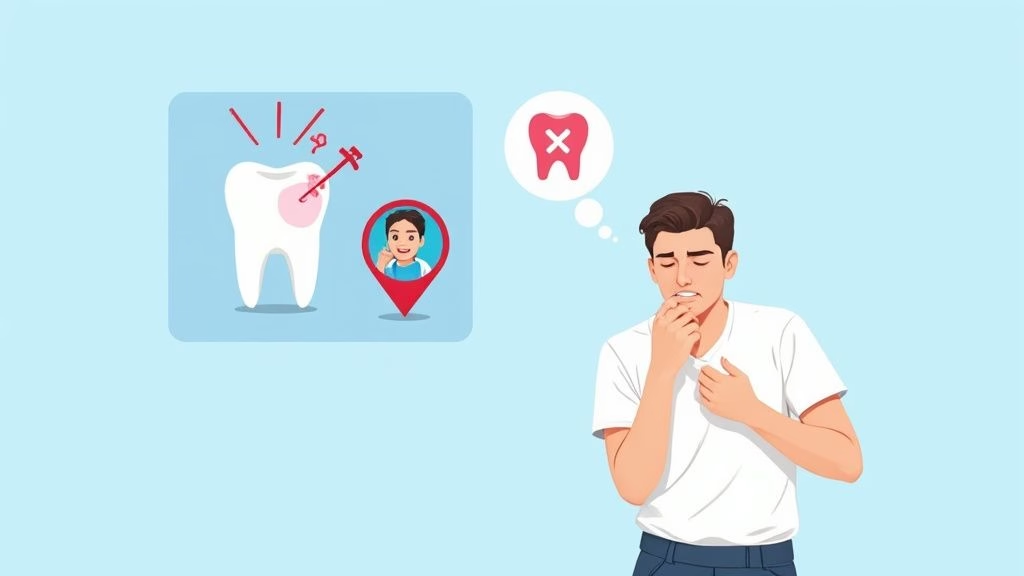What Causes Bad Breath and How to Fix It for Good

Let’s face it, nobody enjoys having bad breath. Whether it’s that stale morning taste or a more persistent issue, halitosis is a common problem that can leave you feeling self-conscious. But what’s really going on in there? Most of the time, the culprit is a specific group of sulphur-producing bacteria having a feast on leftover food in your mouth.
We’re going to get to the bottom of what causes it and, more importantly, what you can do to get back to feeling fresh and confident.
What’s Really Causing Bad Breath?
Bad breath is incredibly common, but the silence and embarrassment surrounding it can make it feel like a lonely battle. The truth is, it affects millions of people. Understanding where it comes from is the first real step towards fixing it for good. It’s more than just a surface-level problem; persistent bad breath is often a clear signal from your body about your oral health and sometimes even your general wellbeing.
Think of your mouth as a bustling ecosystem. When everything is in balance, it functions perfectly. But if certain elements are thrown off-kilter, issues like halitosis begin to surface. The main offenders are specific bacteria that make their home in your mouth, especially on your tongue and tucked away between your teeth.
Bacteria and Those Smelly Sulphur Compounds
These microscopic troublemakers absolutely love to feed on the food debris, dead cells, and proteins you leave behind after a meal. As they break down this material, they release pungent gases called volatile sulphur compounds (VSCs). It’s these compounds that create that distinct, unpleasant smell we all recognise as bad breath. While this is a natural process, certain conditions can send these bacteria into overdrive, making the odour much more noticeable.
It’s a far bigger issue than most people realise. Around 25% of the UK population deals with persistent halitosis. For a staggering 85% of those cases, the problem can be traced directly back to these sulphur-producing bacteria in the mouth. You can read more about the prevalence of bad breath in the UK on Ultradex.co.uk.
This tells us that for the vast majority of people, the solution is found right inside their own mouth. So, what creates the perfect environment for these odour-causing microbes to thrive? A few key things:
- Poor Oral Hygiene: If you’re not brushing and flossing effectively, you’re essentially leaving out a buffet for bacteria.
- Dry Mouth (Xerostomia): Saliva is nature’s mouthwash. It neutralises acids and washes away food particles. When you don’t have enough, bacteria can multiply without anything to stop them.
- Dental Problems: Cavities, gum disease, and even poorly aligned teeth can create the perfect nooks and crannies for bacteria to hide and flourish where your brush can’t reach.
Ultimately, getting rid of bad breath isn’t about covering it up with mints. It’s about tackling the root cause and creating a healthier, more balanced environment in your mouth.
The Hidden Culprits Inside Your Mouth
We’ve all been there – that lingering worry after a strong coffee or a particularly garlicky pizza. While those things can cause a temporary whiff, the root of persistent bad breath is usually much closer to home. In fact, research points the finger directly inside our mouths for about 90% of halitosis cases. Your mouth is a complex ecosystem, and when things get out of balance, it can quickly become a five-star resort for odour-causing bacteria.
So, let’s get to the bottom of it by looking at the three main trouble spots: your tongue, your gums, and the crucial role of saliva. Understanding what’s really going on is the first step to kicking bad breath to the kerb for good.
Your Tongue: The Perfect Hiding Spot
Take a moment to think about the surface of your tongue. It isn’t smooth, is it? It’s covered in tiny bumps and grooves called papillae. These are brilliant for helping us taste our food, but their rough texture also makes them an ideal hiding spot for microscopic food particles, old cells, and, you guessed it, bacteria.
As all this gunk builds up, it forms a noticeable film, especially on the back of the tongue. This environment is anaerobic, meaning it has very little oxygen, which is exactly what the sulphur-producing bacteria thrive on. As they feast on the buildup, they release foul-smelling volatile sulphur compounds (VSCs)—the direct cause of bad breath.
One major study discovered that this tongue coating was the sole cause in 43% of bad breath cases and a contributing factor in countless others. It’s a stark reminder of just how vital tongue hygiene is. You can dig into the full details in the research on halitosis origins.
This is precisely why just brushing your teeth often isn’t enough. If you’re ignoring your tongue, you’re leaving the primary source of the problem completely untouched.
This image really drives home just how much of an impact oral bacteria have compared to other factors.
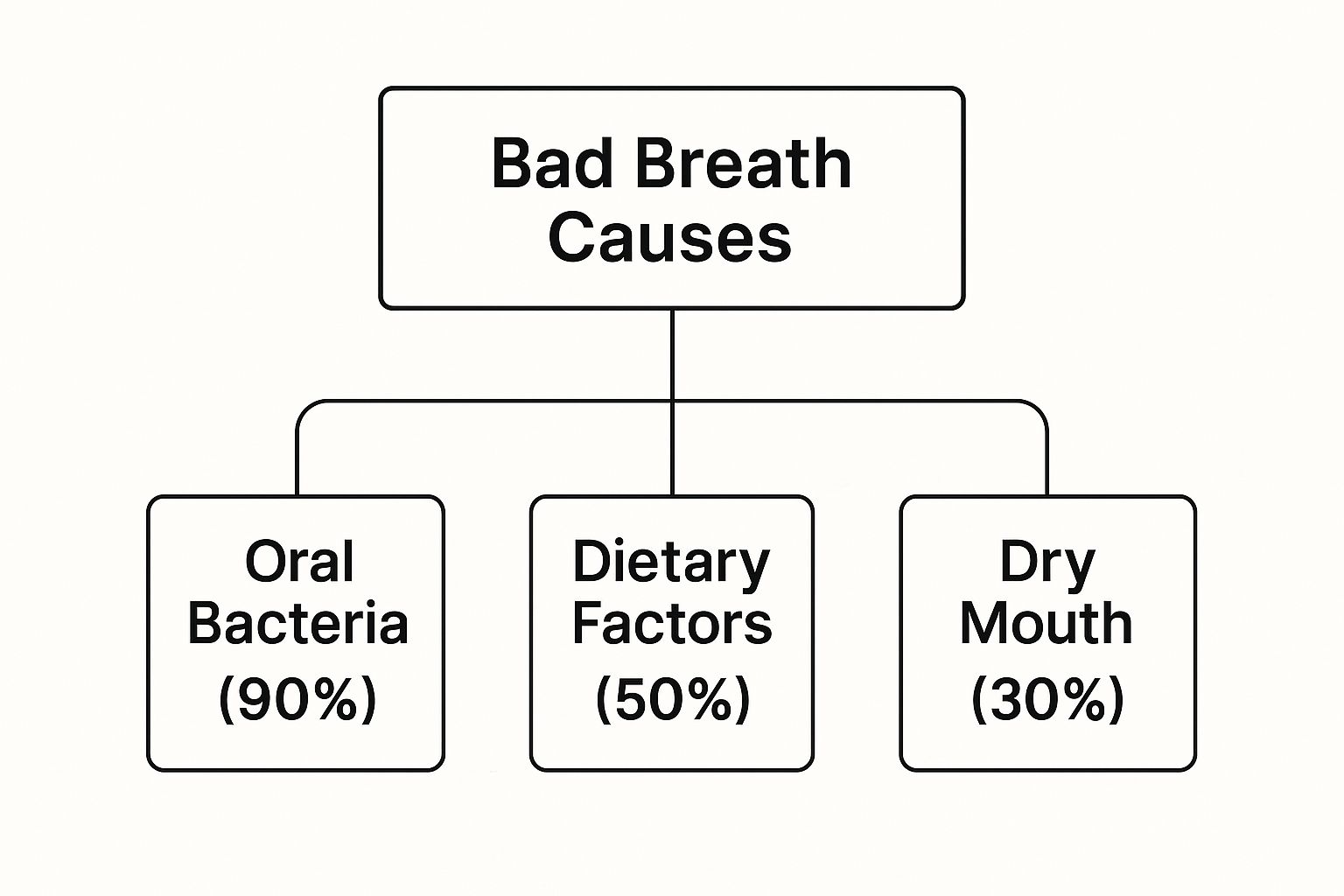
As you can see, what’s happening inside our mouths is overwhelmingly the main driver, though things like diet and dry mouth certainly don’t help the situation.
Let’s break down these oral causes a bit further.
Common Oral Causes of Bad Breath at a Glance
The table below breaks down the most frequent culprits inside your mouth that contribute to bad breath, explaining how each one creates an environment for odour-causing bacteria.
| Oral Cause | How It Contributes to Bad Breath | Key Symptoms to Look For |
|---|---|---|
| Tongue Coating | The rough surface traps food, dead cells, and bacteria, creating an oxygen-poor environment where sulphur compounds are produced. | A visible white, yellow, or brown film, particularly on the back of the tongue. |
| Gum Disease (Gingivitis/Periodontitis) | Bacteria in plaque cause inflammation. Gums pull away from teeth, forming deep pockets that trap more bacteria and decaying tissue. | Red, swollen, or bleeding gums; tender gums; receding gum line. |
| Dry Mouth (Xerostomia) | Lack of saliva means food debris and bacteria aren’t washed away, allowing them to multiply and produce odours. | A sticky or dry feeling in the mouth; difficulty swallowing; a constant sore throat. |
| Poor Dental Hygiene | Infrequent or improper brushing and flossing leaves food particles behind to decay between teeth and along the gum line. | Visible plaque buildup; food frequently stuck between teeth; recurring bad taste. |
Each of these issues creates a perfect storm for halitosis, but understanding them is the key to fighting back effectively.
Gum Disease and Bacterial Pockets
Healthy gums should fit snugly around your teeth, forming a protective seal. But if oral hygiene slips, plaque—that sticky film of bacteria—builds up along the gum line, leading to inflammation. This first stage is called gingivitis.
If left unchecked, it can escalate into periodontitis, a much more serious form of gum disease. Here, the gums start to pull away from the teeth, creating little “pockets.” These pockets are a paradise for anaerobic bacteria; they’re deep, dark, and almost impossible to clean with a standard toothbrush.
Inside these pockets, the bacteria don’t just churn out VSCs. They actively damage the surrounding bone and tissue. This tissue breakdown releases proteins, giving the bacteria even more fuel and making the bad breath significantly worse.
- Plaque Buildup: This is the initial trigger, a sticky film of bacteria that irritates your gums.
- Pocket Formation: As gums recede, they create perfect hiding spots for food and bacteria.
- Intensified Odour: The bacteria thriving in these pockets are a major source of relentless bad breath.
Crowded or crooked teeth can pour fuel on this fire. When teeth overlap, they create tight, awkward spaces that are a nightmare to clean properly. This allows plaque to flourish undisturbed, seriously increasing the risk of gum disease. It’s here that modern solutions like the affordable clear aligners from Toothfairy can be a game-changer, straightening teeth to eliminate those hard-to-reach bacterial traps.
The Critical Role of Saliva
Saliva is your mouth’s unsung hero. Think of it as a natural, 24/7 cleaning service. It’s constantly working to rinse away food debris, neutralise the damaging acids from plaque, and keep bacterial colonies under control. When your saliva flow drops, this whole defence system grinds to a halt.
This condition is officially known as xerostomia, but most of us just call it dry mouth. Without enough saliva, bacteria can multiply at an alarming rate. The mouth becomes stagnant, allowing food particles and dead cells to sit and fester on the tongue and around the gums, fuelling the production of those foul VSCs.
So, what causes dry mouth? It can be several things:
- Medications: Hundreds of common prescription and over-the-counter drugs list dry mouth as a side effect.
- Mouth Breathing: Breathing through your mouth instead of your nose, especially at night, quickly dries out all the tissues.
- Dehydration: This one’s simple but often overlooked. Not drinking enough water throughout the day is a common culprit.
- Lifestyle Habits: Smoking and drinking too much alcohol are both notorious for reducing saliva production.
A dry mouth doesn’t just give you bad breath. It also raises your risk for tooth decay and gum disease because those protective qualities of saliva are missing. Staying hydrated and getting to the bottom of what’s causing the dryness is absolutely essential for both fresh breath and your long-term oral health.
How Your Diet and Lifestyle Impact Your Breath

While most persistent bad breath comes from bacteria living in your mouth, your daily habits and diet can definitely throw fuel on the fire. It helps to think of these as external factors. They can either help you maintain a fresh, healthy mouth or, unfortunately, create the perfect conditions for odour-causing bacteria to thrive. Getting a handle on these connections is a huge step toward managing your breath day-to-day.
Everyone points the finger at garlic and onions, and for good reason. When you eat them, their powerful sulphur compounds get absorbed into your bloodstream. From there, they travel to your lungs and you literally breathe them out. This is why brushing, flossing, and mouthwash don’t completely fix “garlic breath”—the smell is coming from inside until your body has fully processed it.
But the story doesn’t end with a couple of pungent vegetables. You’d be surprised how many common foods and habits are secretly contributing to bad breath.
Surprising Foods That Affect Your Breath
Beyond the usual suspects, plenty of other foods can cause trouble. The high acidity in things like tomatoes can encourage bacterial growth. Even a healthy snack like peanut butter can be a problem; its thick, sticky texture is tough for saliva to wash away, letting it hang around for hours as a feast for protein-loving bacteria.
Here are a few more dietary culprits you might not expect:
- Dairy Products: Cheese, milk, and other dairy items are packed with amino acids. When these mix with the bacteria in your mouth, they can produce stinky sulphur compounds, often leading to a sour smell.
- Sugary Treats: Sugar is basically rocket fuel for the bacteria in your mouth—not just the ones that cause cavities, but the smelly ones, too.
- Coffee: That essential morning brew has a drying effect. It reduces saliva flow, giving odour-causing bacteria the chance to multiply rapidly.
A great way to combat diet-related bad breath is to focus on the basics of clean eating. If you’re looking for a starting point, these clean eating tips for beginners can offer some simple guidance. Sometimes, just making a few smart swaps and drinking more water can make all the difference.
How Lifestyle Habits Worsen Bad Breath
What you do every day matters just as much as what you eat. Choices that seem to have nothing to do with your mouth can directly alter its environment, usually by creating the dry conditions that bacteria absolutely adore. This state, known professionally as xerostomia, is a major player in bad breath.
Smoking is a classic example. It doesn’t just leave its own stale, unpleasant odour; it also massively reduces your saliva production. This creates a chronically dry mouth, which is the perfect breeding ground for bacteria. Alcohol has a similar dehydrating effect, zapping your saliva and making breath noticeably worse.
A dry mouth isn’t just uncomfortable—it’s an open invitation for bacteria. Saliva is your body’s natural rinse cycle, washing away food debris and neutralising acids. When that defence is weakened, bacteria can run wild.
Even popular health trends can have unexpected side effects. Low-carb and keto diets, for example, can cause something aptly named “keto breath.” When your body starts burning fat for energy instead of carbohydrates, it produces chemicals called ketones. These are released through your breath and can have a unique, sometimes fruity or acetone-like smell that has nothing to do with how well you brush your teeth. It’s a perfect illustration of how the cause of bad breath can sometimes start a long way from your mouth.
When Bad Breath Signals a Deeper Health Issue
While most cases of bad breath start and end in the mouth, sometimes a persistent bad smell is your body’s way of sending up a flare. If your oral hygiene is on point but the odour just won’t budge, it might be a sign that something else is going on. It’s not a reason to panic, but it is useful information your body is giving you.
Think of it like the warning light on your car’s dashboard. It doesn’t mean the engine is about to explode, but it does signal it’s time to have a look under the bonnet. Certain medical conditions can produce specific chemicals that travel through your bloodstream to your lungs, which you then exhale, creating a distinct smell.
From Sinuses to Stomach Issues
Often, the problem isn’t far from your mouth at all. Conditions affecting your sinuses, throat, or digestive system are common culprits for breath that isn’t fresh, no matter how much you brush and floss.
A sinus infection, for instance, can lead to mucus and post-nasal drip. This fluid collects at the back of your throat, creating a perfect feeding ground for smelly bacteria. In a similar way, small, foul-smelling clusters of bacteria and debris called tonsil stones can form in the nooks and crannies of your tonsils, leading to a seriously potent odour.
Another frequent offender is gastroesophageal reflux disease (GERD). This is where stomach acid and partially digested food creep back up the oesophagus, bringing their unpleasant smells with them. If your bad breath often comes with heartburn or a sour taste in your mouth, GERD could be the reason.
The Bigger Picture: What Your Breath Could Mean
Sometimes, the clues your breath provides point to body-wide, or systemic, conditions. Your metabolism—the complex process of turning food into energy—can create by-products that have a noticeable scent when you breathe them out.
A distinct, fruity or acetone-like smell (a bit like pear drops or nail polish remover) can be a serious warning sign of ketoacidosis, a complication of uncontrolled diabetes. This happens when the body, starved of insulin, starts burning fat for fuel and produces chemicals called ketones.
This specific link between a breath odour and a serious medical condition really shows how what happens in your mouth can reflect your overall health. Though less common, other serious issues can also show up as halitosis. Certain liver or kidney diseases, for example, can cause a musty or fishy smell because the organs aren’t filtering out toxins properly.
Recognising these signs is the first step. Here are a few key indicators that your bad breath might be more than just an oral hygiene issue:
- It’s Persistent: The odour is constant and doesn’t get better after brushing, flossing, and using mouthwash.
- You Have Other Symptoms: You’re also experiencing things like a stubbornly dry mouth, heartburn, a chronic cough, or unexplained weight loss.
- The Smell is Unusual: The odour is very specific, like a fruity, fishy, or chemical scent.
If you suspect your bad breath is tied to a deeper health problem, your first port of call should be your GP or a dentist. They can help you connect the dots and figure out what to do next. Here at Toothfairy, our dentists can carry out a thorough assessment through an online consultation, helping to rule out oral causes and advising you on whether you need to see a medical doctor for further investigation.
Your Action Plan for Lasting Fresh Breath
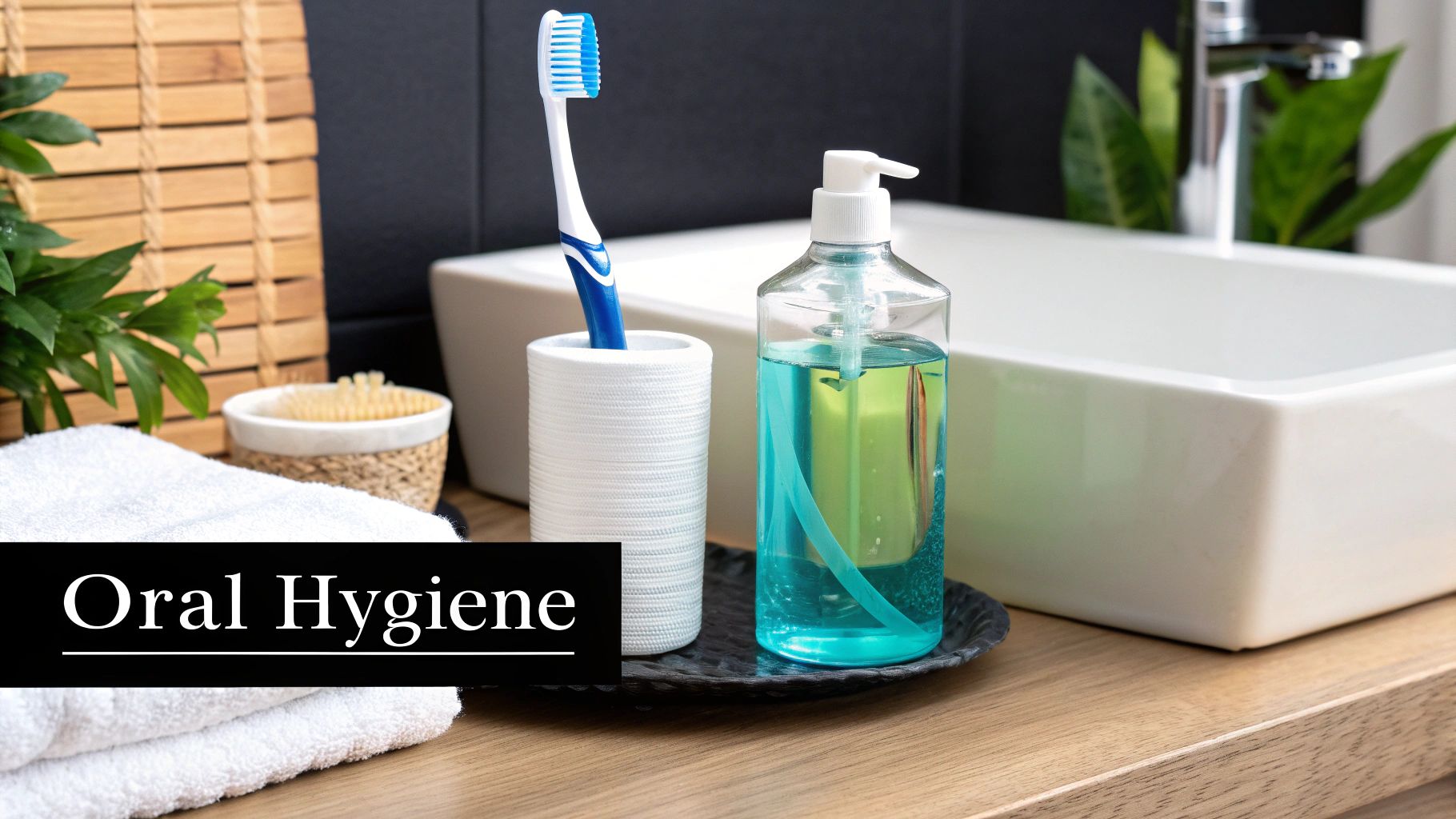
Knowing what causes bad breath is one thing, but actually doing something about it is what really counts. You now understand the culprits, from bacteria lurking on your tongue to crooked teeth creating hard-to-reach hiding spots. It’s time to put that knowledge into action.
This isn’t about finding a temporary fix or a minty mask. We’re talking about creating a healthy mouth where bad breath simply can’t get a foothold. The best approach combines consistent daily care at home with professional help when you need it, tackling the problem from every angle for good.
Building Your Foundational Oral Hygiene Routine
Your daily habits are the absolute bedrock of fresh breath. Without them, nothing else works. A solid routine isn’t just about a quick once-over with a toothbrush; it’s a deliberate strategy to clear out bacteria and food debris from every nook and cranny.
There are three non-negotiables for a truly effective routine:
- Proper Brushing: You need to brush for a full two minutes, twice a day. The trick is to angle your brush at 45 degrees towards your gums. This lets the bristles get just under the gumline where plaque loves to hide. Use gentle, circular motions, not a harsh scrub.
- Daily Flossing: Seriously, don’t skip this. Flossing is the only way to get at the gunk trapped between your teeth and gums. Your toothbrush just can’t reach these spots.
- Tongue Scraping: A huge amount of the bacteria responsible for bad breath lives on your tongue. Every morning, use a proper tongue scraper (or the back of your toothbrush) to gently remove that film.
Think of it as a three-pronged attack that leaves bacteria with nowhere to hide. For a deeper dive into creating an unbeatable routine, check out these top oral health tips from a holistic dentist.
Upgrading Your Approach with Modern Solutions
But what if you’re doing everything right and still struggling? Sometimes, an impeccable routine isn’t enough. If your teeth are crowded or crooked, you’re fighting an uphill battle. Those overlapping areas are nearly impossible to clean properly, turning them into permanent hotspots for plaque and odour-causing bacteria.
This is where modern dentistry can make all the difference. Instead of constantly managing the symptom (the smell), you can fix the root cause. Clear aligners, for instance, are a brilliant, discreet way to straighten your teeth and eliminate those bacterial traps for good.
Crowded teeth aren’t just a cosmetic issue; they’re a health one. By creating places your brush and floss can’t reach, they dramatically increase your risk of bad breath, cavities, and gum disease. Straightening your smile is one of the most powerful long-term moves you can make for your oral health.
While some aligner brands involve high costs and countless trips to the clinic, Toothfairy brings the solution to you. Our app allows a real, UK-based dentist to monitor your progress from the comfort of your home, making a straighter, cleaner smile more accessible and affordable than ever. It’s a smarter way to solve the problem, not just cover it up.
At-Home vs Professional Solutions for Bad Breath
Understanding when your daily efforts are enough versus when you need to call in a professional is key. The table below breaks down the difference between at-home care and professional solutions like those offered by Toothfairy.
| Solution Type | Examples | When It’s Effective | When to Upgrade to Professional Care |
|---|---|---|---|
| At-Home Care | Brushing, flossing, tongue scraping, therapeutic mouthwash. | Perfect for managing bad breath caused by everyday food debris and light plaque buildup. | When bad breath sticks around despite your best efforts with a consistent daily routine. |
| Professional Solutions | Dental cleanings, clear aligners, treating gum disease. | Essential for tackling deep-seated tartar, gum pockets, and structural issues like misaligned teeth. | When you have crowded teeth that create bacterial traps or you spot signs of gum disease. |
In the end, the most effective plan is a two-part strategy. You nail your daily hygiene routine at home, and you get professional support to fix any underlying issues that are holding you back. This way, you’re not just fighting a daily battle—you’re on the path to winning the war against bad breath for good.
Still Have Questions About Bad Breath? Let’s Clear a Few Things Up
Even with all this information, you might still have a few nagging questions. It’s completely normal. Let’s walk through some of the most common queries I hear, so you can get the last few pieces of the puzzle and feel confident about tackling bad breath for good.
Can Children Get Chronic Bad Breath?
Absolutely. It’s a common concern for parents, and the reasons are usually quite similar to those for adults. More often than not, it comes down to simple oral hygiene. Little ones are still learning, and if brushing and flossing aren’t quite up to scratch, food particles and bacteria quickly build up.
Other culprits are common in kids too. Many children breathe through their mouths, especially at night, which dries everything out and lets bacteria have a field day. Things like sinus infections or even swollen tonsils can also be a factor, as they can trap tiny bits of food. In some rare cases, the source can be as strange as a small bead or piece of food stuck up a nostril!
If you’ve established a solid brushing and flossing routine at home but the smell isn’t going away, it’s a good idea to book a dental visit. A dentist can check for things like hidden cavities that might be causing the odour.
Does Mouthwash Actually Cure Bad Breath or Just Mask It?
That’s a brilliant question, and the answer really hinges on which mouthwash you’re using. Most of the standard mouthwashes you grab off the supermarket shelf are what we’d call ‘cosmetic’. They’re designed to give you a temporary blast of minty freshness, covering up the smell for a little while, but they don’t do much to solve the underlying problem.
On the other hand, you have ‘therapeutic’ mouthwashes. These are a different beast altogether. They’re formulated with active ingredients that actually target and kill the specific bacteria that produce those smelly sulphur compounds. They can be a really effective part of your overall game plan.
Think of mouthwash as a great support player, not the star of the show. For a genuine, lasting fix, it has to be part of a complete routine: thorough brushing, daily flossing, and tongue scraping. These actions physically remove the source of the bacteria.
Ultimately, even the best mouthwash can only manage the symptoms. It won’t fix the root cause, like gum disease or bacteria hiding away where your brush can’t reach.
I Brush and Floss Every Day. Why Do I Still Have Bad Breath?
This is one of the most frustrating situations to be in. You’re doing all the right things, but the problem just won’t go away. When your basic hygiene is solid, it’s a clear sign that you need to dig a little deeper for the cause.
One of the first places to look is your tongue. It’s amazing how many people miss this step. The rough surface of your tongue is a perfect breeding ground for odour-causing bacteria, and if you’re not scraping it clean every day, you’re leaving a major source of the smell behind.
If you’re already a dedicated tongue-scraper, here are a few other things that could be at play:
- Dry Mouth (Xerostomia): A surprising number of common medications can reduce your saliva flow. Less saliva means less natural rinsing, creating the perfect dry environment for bacteria to multiply.
- Underlying Medical Conditions: Sometimes, the source isn’t in your mouth at all. Issues like persistent acid reflux (GERD) or chronic sinus problems can produce odours that travel up and out of your mouth.
- Old Dental Work: A faulty crown, a cracked filling, or a bridge can create tiny, impossible-to-clean crevices. These spots become traps for food and bacteria.
This is exactly when you need a professional opinion. A dentist can have a proper look, find the specific culprit, and help you create a plan to finally get rid of the problem.
How Do Crooked Teeth Contribute to Bad Breath?
This is a fantastic point because it directly connects the physical structure of your mouth to your oral health. When teeth are crowded, overlapping, or twisted, they create a minefield of tight spots and awkward angles. A toothbrush and floss just can’t get into all those nooks and crannies.
These hard-to-reach areas are magnets for plaque and bits of food. They essentially become protected sanctuaries where odour-causing bacteria can thrive without being disturbed. This not only causes chronic bad breath but dramatically increases your risk for cavities and gum disease down the line.
Straightening your teeth gets rid of these hiding spots. By aligning your smile, you’re creating smooth, even surfaces that are much, much easier to keep clean. You’re directly addressing one of the major structural causes of bad breath.
While the thought of braces can be off-putting, modern solutions have made this a lot more accessible. With Toothfairy, for instance, you can get a straighter, healthier smile using discreet clear aligners. The whole process is prescribed and monitored remotely by a real UK-based dentist, making it a smarter and often more affordable way to gain fresh-breath confidence.
Ready to tackle the root cause of bad breath for good? Whether you need expert advice for a persistent issue or want to explore how a straighter smile could transform your oral health, Toothfairy makes professional dental care simple and accessible. Visit our website to start your journey with a qualified UK dentist today.
Last updated on August 15, 2025

Toothfairy Care Team
Toothfairy, is the world's smartest dental app, that connects patients to a dentist for a range of issues, from emergencies, cosmetics, prescriptions to virtual exams.
Toothfairy Care Team
Toothfairy, is the world's smartest dental app, that connects patients to a dentist for a range of issues, from emergencies, cosmetics, prescriptions to virtual exams.

